Cambridge B1 Preliminary (PET): How to write an article in 2021
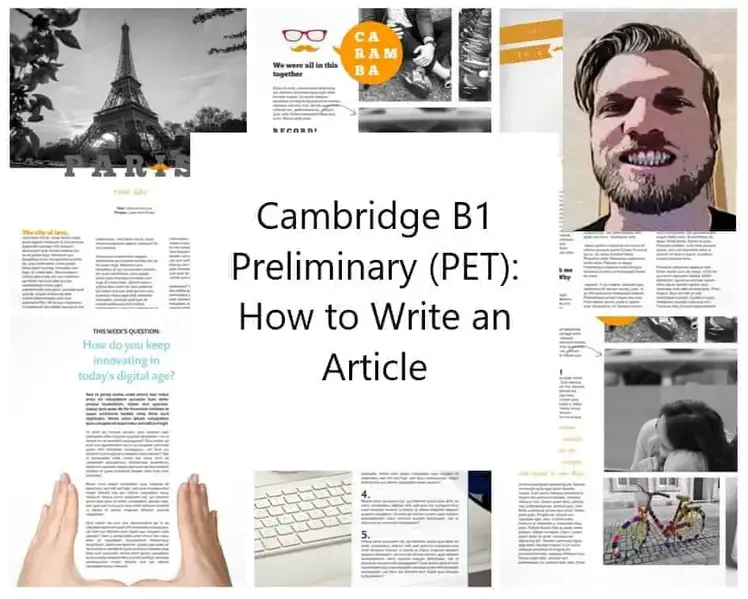
Home or cinema – How do you watch your favourite films? I know many people who love animated or romantic films, but for me, there is nothing better than an amazing drama or adventure movie like ‘Indiana Jones’ because I’m a big fan of stories with a fascinating plot. In my opinion, watching a film at home isn’t the same as going to the cinema to enjoy a great movie on a huge screen with popcorn and cola. If it wasn’t so expensive, I would go every week. So, if you want to give me some money to go to the cinema more often, or to tell me which you prefer – the cinema or the TV screen, leave a comment.

Introduction
What does a typical article task look like, how to organise your article, always make a plan, the different parts of an article, main paragraphs.
I know many people who love animated or romantic films, but for me, there is nothing better than an amazing drama or adventure movie like ‘Indiana Jones’ because I’m a big fan of stories with a fascinating plot. In my opinion, watching a film at home isn’t the same as going to the cinema to enjoy a great movie on a huge screen with popcorn and cola. If it wasn’t so expensive, I would go every week.
In the first paragraph I talk about film genres (animated, romantic, drama, adventure) as well as one specific film (Indiana Jones). I also tried to include some interesting grammar (I know many people who…, nothing better than) and vocabulary (amazing drama, I’m a big fan of…, fascinating plot). On top of that, I used different linking words to connect my ideas (who, but, because).
Final sentence
So, if you want to give me some money to go to the cinema more often, or to tell me which you prefer – the cinema or the TV screen, leave a comment.
Start to practise today
Similar posts, cambridge b1 preliminary (pet): everything you need to know in 2021, cambridge b1 preliminary (pet): reading part 5, cambridge b1 preliminary (pet): reading, cambridge b1 preliminary (pet): reading part 6, cambridge b1 preliminary (pet): how to calculate your score, cambridge b1 preliminary (pet): how to write an email in 2021, 24 comments.
- B1 Preliminary (PET)
- B2 First (FCE)
- C1 Advanced (CAE)
- C2 Proficient (CPE)
Not a member yet?
- Part 1 0 / 25
- Part 2 0 / 25
- Part 3 0 / 25
- Part 4 0 / 25
- Part 5 0 / 25
- Part 6 0 / 25
- Part 1 0 / 20
- Part 2 0 / 20
- Part 3 0 / 20
- Part 4 0 / 20
- Part 1 NEW 0 / 10
- Part 2 NEW 0 / 10
- Part 3 NEW 0 / 10
- Part 4 NEW 0 / 10
Get unlimited access from as little as 2.60 € / per month. *One-time payment, no subscription.
Type: Email
| Nina Hello Jane, I’m writing because, as you know, Olivia is leaving our school and moving to Canada. I thought we could organize a surprise party for her. Do you think it’s a good idea? If so, can you think of a good place to have the party? Would it be best to have it on a weekday or at the weekend? Also, I’m thinking of hiring a DJ for the party. Do you know what sort of music Olivia likes best? Email me soon! |
Write your email to Nina using all the notes.
| Sam Hi Angela, I’m really looking forward to your visit. How long has it been since we last saw each other? I’m trying to think of fun things to do when you get here. You said you like to go to London. Is there anything special that you would like to do there? Dad said he would take us on a day trip to either Oxford or Cambridge. Which one would you prefer? Also, are you still a vegetarian or do you eat meat now? Email me soon! |
Write your email to Sam using all the notes.
- New account
Login into your account...
Not a memeber yet? Create an account.
Lost your password? Please enter your email address. You will receive mail with link to set new password.
Back to login

Cambridge English: Preliminary
Practice tests for the Cambridge PET exam
Writing Practice Tests
Cambridge english preliminary: writing practice tests.
Writing is tested in Paper 1 of the Cambridge English Preliminary Test. There are 3 writing tasks and we've included practice tests for each part below. We will be adding more tests soon.
Part 1: Email Part 2: Article Part 2: Story
More help with the Preliminary English Test Writing Paper
Get higher scores in your PET Writing practice tests with these quizzes to help you improve your writing skills.
Paraphrasing 1 Paraphrasing 2 Paraphrasing 3 Paraphrasing 4
Contractions in Informal Emails It is very important to write your Part 1 email in the correct style. One way of achieving an informal style is to remember to use contractions.
Phrases for informal emails Use these words and expressions to help you write your email in an informal style.
Paragraphs in informal emails Organising your email into clear paragraphs will help you to structure your email and will make it easier for the examiner to see your organisation.
We all have our own strengths and weaknesses when we are learning a language. In writing this includes our use or grammar, vocabulary and punctuation. Get to know which areas of English you need to improve by keeping a record of your most common mistakes. Then the next time you do any writing check for these mistakes before you finish.
|
|
|
|
| Articles |
|
|
Breakout English

Preliminary (PET)
Breakout English has plenty of Preliminary (PET) materials which can be used to prepare for the Cambridge B1 exam. The PET exam is often the first time candidates step into the world of official exams, making it a significant challenge. Cambridge doesn’t make it easy either. While the exam doesn’t include the dreaded Use of English seen at higher levels, it still has demanding Reading, Writing, Listening and Speaking sections.

B1 fixed phrases, dependent prepositions and collocations

How to write an email – PET Writing Part 1

Preliminary (PET) Reading Part 6 – Open Cloze

Preliminary (PET) Writing Sample Tests

How to do Preliminary (PET) Reading Part 2

Pictures to describe for Preliminary (PET) Speaking Part 2

Dead Famous – Past Simple Game

Describing a Picture – Preliminary (PET) Speaking Part 2 Plan

Christmas Songs Listening

Make and Do – Collocations

Writing an Article – Rhetorical Questions

Preliminary (PET) Speaking – Sample Tests

Preliminary (PET) Reading Part 4 – Rudolph the Red-Nosed Reindeer

First day get to know you questions

Cambridge Exam Changes 2020 – Updates for Preliminary (PET) and Key (KET)

Preliminary (PET) Writing Part 2 – Emoji Story 😀

Liar, liar! – present perfect / past simple game

Preliminary (PET) Transformations – Conditionals

How to teach Cambridge exam classes

Preliminary (PET) Speaking Parts 3 & 4

Expressing Preferences – Would you rather…

Preliminary (PET) Transformations – Passive

Preliminary (PET) Transformations – Comparatives and Superlatives
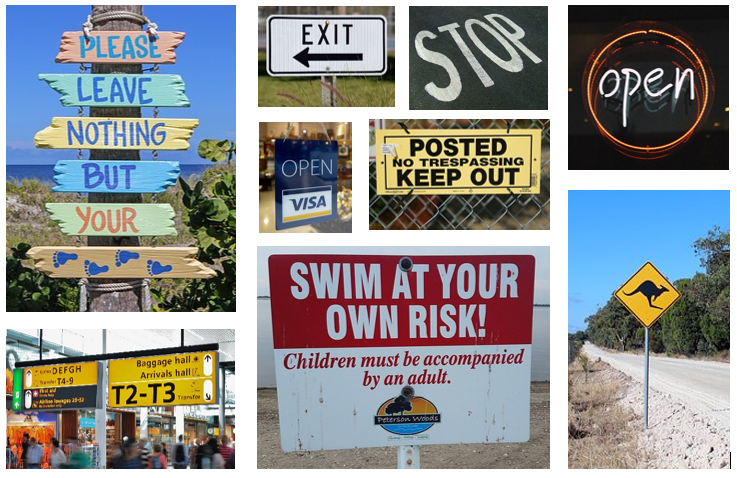
How to do PET Reading Part 1 – Signs and Modals of Obligation

Cambridge Speaking Part 1 – Chat Cards

First day of exam class – Get to know the exam (Cambridge)

Preliminary PET Writing Part 1 – Improve a letter
No post found
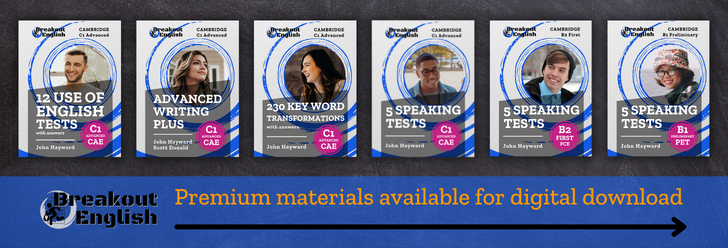
How to prepare for Preliminary PET exam
Passing the Cambridge PET exam is all about getting the basics down. Once you’ve got a solid grasp of basic grammar and vocabulary, you need to work on practising the four skills of reading, writing, listening and speaking. You can also start to learn some more advanced concepts to try to capture the highest marks in the exam, but remember not to complicate your life too much.
Here are some things you can do to prepare for the exam:
- Study vocabulary – Vocabulary can be one of the biggest challenges at B1 level. Using course books designed for a B1 level will often expose you to a lot of vocabulary about common topics for the level including travel, shopping, describing a town or city and much more.
- Perfect the basic grammar – You should be able to write and speak in the present, past and future without making lots of mistakes. Memorise your irregular verbs, work on using modal verbs to give advice and discuss obligation and in general get those basics covered.
- Start listening to more English – There are some great websites like BBC 6 Minute English which give intermediate level learners the chance to practice listening without getting overwhelmed. Try to make listening in English part of your study routine.
- Get a graded reader – Graded readers like these ones from Penguin Books are novels and stories which have been adapted to a specific level. Find one at B1 level and get reading!
- Learn how to organise your writing – The biggest problem a lot of PET exam writing has is a lack of organisation. You don’t need to write Shakespeare for the Preliminary exam, but you do need to organise a letter, article and story in a logical way.
- Take a class or find a language exchange partner – It can be hard to find opportunity to speak in English, especially if you are self-conscious about your speaking. Force yourself to speak by taking a class with other learners at your level. The teacher will help too!
- Do some practice exams – You should never take an official exam without practising first. There are books available with practice exams where you can check your own answers and get a feel for the real day.
Enjoy the Preliminary (PET) materials!
More Cambridge materials


Exam English ✓
- B1 Preliminary (PET)
- B1 Preliminary for Schools
- Cambridge exams
Free Practice Tests for learners of English
Pet writing part 1, writing tests.
- part 1 - email
- part 1 - email 2
- part 2 - article
- part 2 - story
2021 © Exam English Ltd. ALL Rights Reserved. Home | Terms of Use | Privacy policy Cookie preferences. -->
Writing the Perfect Email for B1 Preliminary (PET)
Luis @ kse academy.
- noviembre 14, 2019
As we’ve already seen in the B1 Writing Guide (in Spanish), updated for the 2020 changes , the Writing component consists of 2 parts. The first one is an email whereas the second one is a story or an article, as you can choose which to do. For this reason, in this post I’m going to teach you how to write an email at B1 level for your Preliminary (PET) exam .
Email structure
Saying goodbye.
Este artículo también está disponible en castellano.
How to Write an Email for B1 Preliminary (PET)
In order to know the steps to write an email for this B1 exam , the first thing we need to do is to find out what the instructions are like and know what you’re expected to do. And even though we saw this in the B1 Writing guide (in Spanish), we will now go over it again and dive in even deeper.
Instructions for Writing B1 Preliminary Part 1: Email
In this part of the test, you are given an email from an English friend or relative, and you are asked to respond to it in about 100 words . This email contains annotations which help you identify exactly what you need to respond to.
As regards the topics, they’re usually not very difficult, as you’re expected to write at an intermediate level, about topics you are familiar with: sports, hobbies, TV programmes, the weather, your town/city, etc. Here’s an example taken from Cambridge English sample papers :
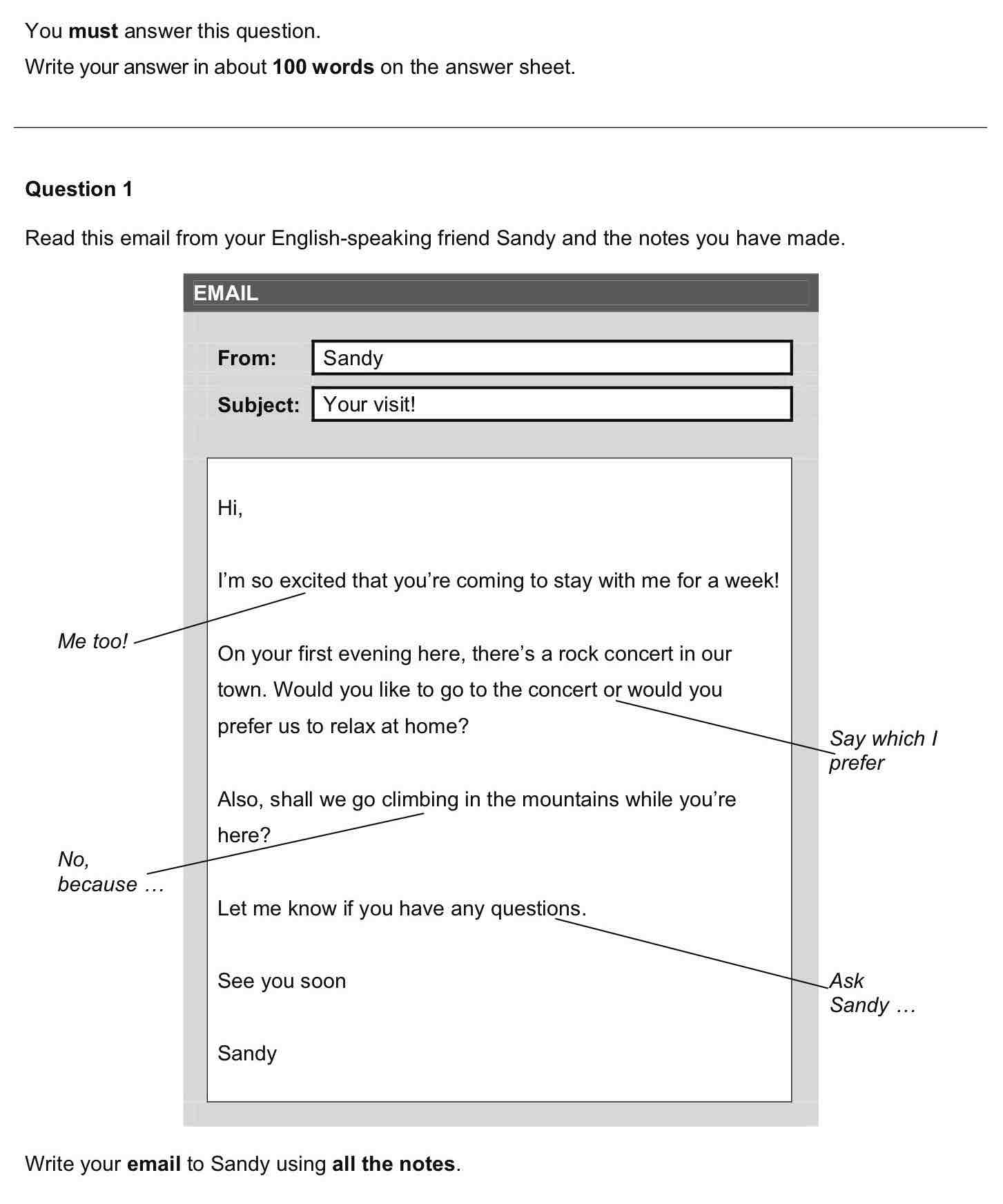
As you can see in the example above, taken from Cambridge’s official website, we have received an email from a person so-called Sandy , who is a friend of ours. In addition, we have made some annotations, which are the points we need to address in your email:
- Say which I prefer
- No, because…
- Ask Sandy…
In this sense, Cambridge is making this task easier, as we definitely won’t go blank and they are pointing out the structure that our email should have , which we will see in the following section.
The first thing you need to know is the different parts of an email , and these are:
- Greetings: we greet the other person (i.e. say «hi» or «hello»).
- Opening paragraph: we react to the other person’s news and ask them how they are feeling and whatever else you feel is appropriate.
- Main paragraph 1: in this paragraph we deal with the first important point, which we can identify in the instructions.
- Main paragraph 2: if there is a different point to deal with, this paragraph will do so.
- (We might have more main paragraphs, depending on the task.)
- Closing paragraph: in this paragraph we «start» to say goodbye by wishing the other person well and asking them to reply to your email.
- Goodbye: we use a short expression to say goodbye.
- Signature: we sign the email with our name.
In general, all emails must follow the same structure, and also, I recommend you following these two pieces of advice::
- Don’t write From: y To: , as it is completely unnecessary and Cambridge won’t penalise you. Also, you’re saving words which you can use in the body of your email.
- Don’t write a subject , for the same reason as before.
Now that we know the different parts of an email, we should see an example.
Example Email for PET Writing Part 1
Let’s take a look at the following example of a Preliminary (PET) task answer for Writing Part 1 , where we can see an answer to the sample task we saw above:
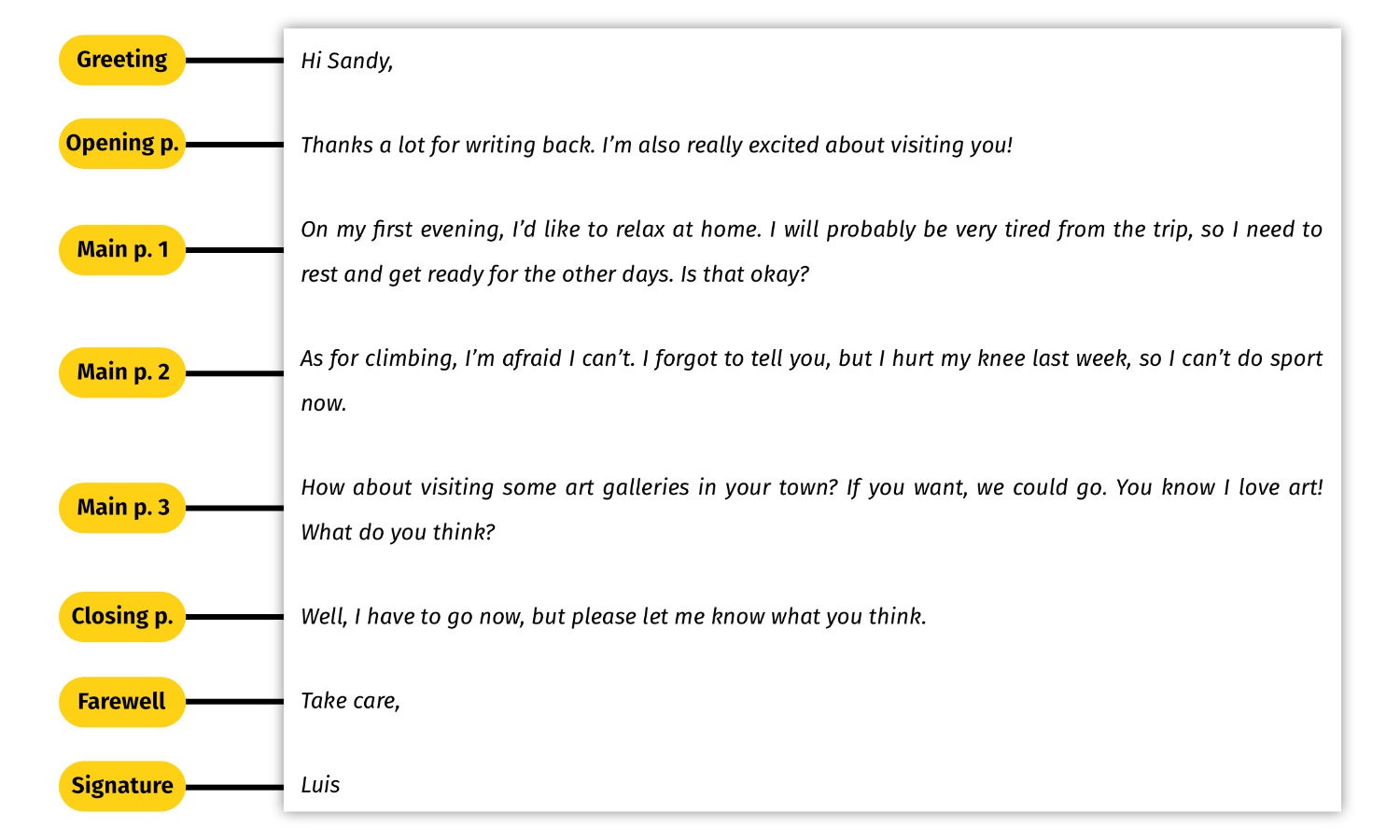
In the example above, you can see the different parts of an email well defined. It’s important that your writing is visually appealing , apart from having good grammar and vocabulary. This means that the paragraphs should be well defined , with a space in between, and that you should know when to break lines. This is specially important after greetings, after opening and closing paragraphs, and after saying goodbye. This will make your text visually appealing, as it will look like a real email.
Expressions to use in your email
In this section, we are going to focus on different expressions you can use in the different parts of the email . While the main paragraphs will vary completely depending on the topic of your writing, most of the other parts in the email can be practised and memorised almost completely. Let’s take a look:
In order to start your email in Writing Part 1 for Cambridge English: Preliminary (PET) , you can use different expressions, which are really typical and easy to remember. We have 3 basic ways to greet in this kind of writing, which is usually for a friend or family member:
- Hi John,
- Hello John,
Notice how «hi» is less formal than «hello» or «dear». Also, don’t forget to write a comma (,) right after greeting your friend or relative. After greeting the addressee (i.e. the person who will read the email), you must start the opening paragraph in a new line .
Opening paragraph
The opening paragraph is the place to react to your friend’s or relative’s email . In order to do so, you can use a number of different expressions. Here we have some examples:
- It’s nice / great / good to hear from you.
- It’s nice / great / good to read your email.
- I’m glad to hear your news.
- I’m excited about… (your news.)
- It’s great to hear that…
- I’m sorry to hear that…
- I’m really sorry to read your news.
- Thanks a lot for writing!
- It was good to receive your email.
- Thank you very much for your email.
And many more. Also, it’s a good idea to ask your friend or relative how they are feeling , which you can do like this:
- Hope you are doing well.
- How’s it going?
- How are you (doing)?
- How are things (going)?
You can also add some information that you think is relevant or necessary, but don’t expand this paragraph very much, because the important information must go in the main paragraphs .
Main paragraphs
For the main paragraphs, there aren’t any fixed expressions which you must use, as it depends mostly on what you have to write about. However, you should try to make use of connectors and appropriate punctuation . So let’s take a look at common useful connectors and the punctuation we use them with:
- … and… : to connect two similar things or ideas.
I love reading and listening to music. My favourite meal is fish and chips.
- …, but… : to connect two contrasting ideas.
I love watching Tv , but I don’t have a favourite show. I am reading a book, but I don’t remember the title.
- . However, … : to connect contrasting ideas.
Last month, I went to the cinema . However, I didn’t enjoy the movie. I am a very big fan of this author . However, I haven’t read his last novel.
- Moreover, … : to add more information about something.
- … because… : to justify an opinion or idea.
My mum is the perfect cook because she knows a lot of recipes and has plenty of experience. Moreover, she experiments with different ingredients all the time.
- . Because of that, … : to justify an opinion, fact or idea.
My mum likes to cook using new ingredients all the time. Because of that, she creates original dishes every month.
- . As for…/ Regarding… : to switch to a new topic. For instance, you can use this connector to start the second main paragraph.
As for/Regarding why I like this cookery show, I think it’s because it’s a great way to see new recipes.
- Time linkers: then, after that, yesterday, this morning, last summer, etc.
Last night, I watched a very good action film.
With many connectors, we typically use a comma (,) after it when we start a sentence (e.g.: However, Last night, Moreover, etc. ).
Closing paragraph
As we mentioned earlier, a closing paragraph in this Writing part 3 is used to start saying goodbye to the addressee and to ask for a response to your email. So we can use the following expressions:
- Well, it’s time to say goodbye.
- Anyway, I have to go now.
- Well, it’s time to go.
- Anyway, gotta go.
- I really hope to hear from you soon.
- I’m looking forward to hearing from you.
- I hope you write back soon.
- Make sure you write back soon.
Also, if you still have to write more words, you can add a question for a subsequent email. This question should be related to the topic of your piece of writing.
There are many ways in English to close an informal email. The most frequently used ones are the following:
- Best wishes,
- Sincerely,
- Take care,
- All my love,
- Lots of love,
- See you soon,
- Regards,
Notice how there is a comma (,) after each of the phrases . Also, after writing any of these sentences, make sure you write your name on a different line . And write your name without a full stop!
Another example of an email at B1 level
Now that we know what expressions we should be using in our writing, we are going to take a look at another task and a sample answer. In this case, this is an example of an old task, but the email follows the same rules. Pay close attention to how it’s structured and how its paragraphs are well defined and separated:

Notice how the expressions in bold are used. Whenever you write an email, you should think about this type of expressions and make sure you use them appropriately .

Top 5 Tips for writing an Email for B1 Preliminary (PET)
- Learn and memorise a set of expressions . Make sure you already know a set of expressions to use in your greetings, opening and closing paragraphs, and to say goodbye. This will save you a lot of time while doing a task, and you will avoid making silly mistakes as you will already know the expressions by heart.
- Write a well-structured and visually-appealing email . One of the things Cambridge English examiners pay attention to is the organisation of your piece writing, so make sure not to write a messy email. Also, remember that punctuation matters , so be sure to separate your sentences with stops and commas and don’t write excessively long sentences.
- Brainstorm, write, read and edit . Before starting to write your email, brainstorm a couple of things and write down some ideas. This can include vocabulary related to the topic. For example, if you have to write about TV shows, you can write down thinks like «contestants», «cookery show», «prize», etc. Then, write out your email. After that, read it and look for possible mistakes or opportunities for improvement (e.g.: adding descriptive adjectives, rephrasing sentences, etc.).
- Read carefully and identify the task . Don’t start writing right away. Make sure you read the task carefully and that you identify exactly what you are being asked. Sometimes, we don’t pay attention to the instructions and we end up writing about something different. This will mean losing points, in a very silly way, I must say.
- Experiment at home, be conservative in the exam . Homework is the best chance to be creative and experiment different ways to express yourself. So make sure you try your hardest to keep improving when you write at home. On the other hand, when you’re doing an exam, don’t risk trying out new words or expressions, as you may be making a terrible mistake. So be safe in your exam and stick to what you already know works .
Did you find this post useful? Did you? Well, don’t forget to comment and share. And if you love the English language, follow KSE Academy on Facebook, Twitter & YouTube! And don’t forget to subscribe to the blog!
Oh, and don’t forget to keep smiling!
44 comentarios en “Writing the Perfect Email for B1 Preliminary (PET)”
EXCELLENT HELP FOR THE NEW 2020 PET FORMAT. THANKS A LOT
Hi Liliana! Thanks a lot for your comment! Take care!
Grazie mille di tutto, saluti dall’ Italia
you are great Luis. Thanks a lot for your good work. Paqui Muñoz Mendoza
Thank you very much, Paqui. It’s great to receive comments like this from time to time.
Thanks Luis
Your help was so useful. Thanks.
Thanks for your comment, Rocío. Take care!
Thank you so much!
Thank you so much for sharing. It’s very useful and helpful.
Thank you! 🙂
Nice work, Luis! I’m continuing my classes online during the coronavirus, and this post provides a great, visually-appealing review of this part of the new test. I will be sending my students here next week to help with their homework!
Thank you very much for your comment. Hope your students find it useful. Take care!
The best email. that I found. Thanks.
Thank you, Angelines! 🙂
Super clear!!!! Thank you very much. Claudia
Thank you, Claudia! 🙂
EXCELLENT GUIDE!! THANK YOU SO MUCH FOR SHARING IT
Thank you for your comment, Paola. 🙂
You’re welcome! 🙂
Thank you soo much, im 12 and doing the test, this is the day before the test and your info was soo usfull, have a good evening
Hi, Cameron. Thanks a lot for your comment. Sorry for taking so long to reply. I hope you passed your test! 😀
Absolutely clear guidelines for Writing Part 1 Email Thanks a lot for sharing it!!!
Thank you so much for your comment! 🙂
Great work! Thank you for sharing
Thank you for reading, Susana! 🙂
Happy New Year! Useful tips, good job. Thanks!
Thank you so much for your feedback. Take care and Happy New Year to you too!
THANK YOU VERY MUCH MY DEARRRRRR. I’m having the Cambridge PET exam tomorrow and I’m really nervous… Wish me luck!
Hey, Camila! Hope your exam was fine! Don’t forget to come back here and let us know your score! 🙂
I love you Luis
Haha, thank you, Carlos! Love u too!
Precious guide and helpful insight, thank you.
Thank you very much! 🙂
Great post, thanks!
Thank you, Juliana! 🙂
As an exam coach myself, I really want to congratulate you for this wonderful and useful site. It’s great to see an updated B1 Preliminary writing guide; I’m using it right now with the candidates I teach. Keep up the great work!
Hey, Lenin. Thanks a lot for such a nice comment. I hope your students find it useful. If you ever have any feedback, let me know. Thanks again!
Extremely detailed and useful guidance for those who is taking the PET exams! Thanks a lot.
OLIVIA 15/1/2023 A LAS 11:49 Hello, happy new year.
As an exam preparation teacher myself, I would like to thank you for all your hard work. Yours is the best site I have found online with important tips and useful samples for our students. Keep up the great work! I really appreciate it!
Thank you very much for your comment, Tulia. 🙂
Deja una respuesta Cancelar la respuesta
Tu dirección de correo electrónico no será publicada. Los campos obligatorios están marcados con *
Comentario *
Correo electrónico*
Guarda mi nombre, correo electrónico y web en este navegador para la próxima vez que comente.
- Clases privadas
- Prueba de nivel
- Condiciones
- Política de privacidad
Cambridge English
- A2 Key (KET)
- B1 Preliminary (PET)
- B2 First (FCE)
- C1 Advanced (CAE)
- C2 Proficiency (CPE)
- Linguaskill
Blog de inglés
- Gramática inglesa
- Phrasal Verbs
- Diferencias
- Enviar mensaje
- 958 964 684
- Calle Arabial 4, 18004 Granada
- Lista de espera
Comienza a escribir y presiona Intro para buscar
Last updated 27/06/24: Online ordering is currently unavailable due to technical issues. We apologise for any delays responding to customers while we resolve this. For further updates please visit our website: https://www.cambridge.org/news-and-insights/technical-incident
We use cookies to distinguish you from other users and to provide you with a better experience on our websites. Close this message to accept cookies or find out how to manage your cookie settings .
Login Alert

- < Back to search results
- Selected Philosophical Essays
Selected Philosophical Essays
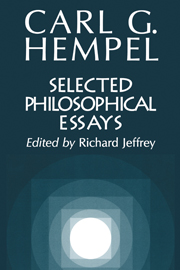
- Get access Buy a print copy Check if you have access via personal or institutional login Log in Register
- Cited by 16

This Book has been cited by the following publications. This list is generated based on data provided by Crossref .
- Google Scholar
- Carl G. Hempel
- Edited by Richard Jeffrey
- Export citation
- Buy a print copy
Book description
Carl Gustav Hempel (1905–97) was one of the preeminent figures in the philosophical movement of logical empiricism. He was a member of both the Berlin and Vienna circles, fled Germany in 1934 and finally settled in the US where he taught for many years in New York, Princeton, and Pittsburgh. The essays in this collection come from the early and late periods of Hempel's career and chart his intellectual odyssey from a rigorous commitment to logical positivism in the 1930s (when Hempel allied himself closely with Carnap) to a more sociological approach close in spirit to the work of Neurath and Kuhn. The collection brings together essays which have up till now been difficult to find, four of which are appearing in English for the first time. Cumulatively they offer a fresh perspective on Hempel's intellectual development and on the rise and demise of logical empiricism.
- Aa Reduce text
- Aa Enlarge text
Refine List
Actions for selected content:.
- View selected items
- Save to my bookmarks
- Export citations
- Download PDF (zip)
- Save to Kindle
- Save to Dropbox
- Save to Google Drive
Save content to
To save content items to your account, please confirm that you agree to abide by our usage policies. If this is the first time you use this feature, you will be asked to authorise Cambridge Core to connect with your account. Find out more about saving content to .
To save content items to your Kindle, first ensure [email protected] is added to your Approved Personal Document E-mail List under your Personal Document Settings on the Manage Your Content and Devices page of your Amazon account. Then enter the ‘name’ part of your Kindle email address below. Find out more about saving to your Kindle .
Note you can select to save to either the @free.kindle.com or @kindle.com variations. ‘@free.kindle.com’ emails are free but can only be saved to your device when it is connected to wi-fi. ‘@kindle.com’ emails can be delivered even when you are not connected to wi-fi, but note that service fees apply.
Find out more about the Kindle Personal Document Service .
Save Search
You can save your searches here and later view and run them again in "My saved searches".
Frontmatter pp i-iv
- Get access Check if you have access via personal or institutional login Log in Register
Contents pp v-vi
Preface pp vii-x.
- By Richard Jeffrey , Princeton, NJ
Dates pp xi-xii
Introduction pp 1-4.
- Philosophical Essays, Early and Late
TRUTH pp 5-8
Chapter 1 - on the logical positivists' theory of truth pp 9-20, chapter 2 - some remarks on “facts” and propositions pp 21-25, chapter 3 - some remarks on empiricism pp 26-34, chapter 4 - the problem of truth pp 35-74, chapter 5 - the irrelevance of the concept of truth for the critical appraisal of scientific theories pp 75-84, probability pp 85-88, chapter 6 - on the content of probability statements pp 89-123, chapter 7 - on the logical form of probability statements pp 124-134, chapter 8 - a definition of “degree of confirmation” (with p. oppenheim) pp 135-162, methodology pp 163-164, chapter 9 - the logical analysis of psychology pp 165-180, chapter 10 - schlick and neurath: foundation vs. coherence in scientific knowledge pp 181-198, chapter 11 - on the cognitive status and the rationale of scientific methodology pp 199-228, chapter 12 - provisoes: a problem concerning the inferential function of scientific theories pp 229-250, memoirs pp 251-252, chapter 13 - rudolf carnap: logical empiricist pp 253-267, chapter 14 - the vienna circle and the metamorphoses of its empiricism pp 268-287, chapter 15 - hans reichenbach remembered pp 288-294, chapter 16 - empiricism in the vienna circle and in the berlin society for scientific philosophy: recollections and reflections pp 295-304, c. g. hempel's publications pp 305-314, index pp 315-317, altmetric attention score, full text views.
Full text views reflects the number of PDF downloads, PDFs sent to Google Drive, Dropbox and Kindle and HTML full text views for chapters in this book.
Book summary page views
Book summary views reflect the number of visits to the book and chapter landing pages.
* Views captured on Cambridge Core between #date#. This data will be updated every 24 hours.
Usage data cannot currently be displayed.
Main navigation
A2 key preparation, resources for teachers and learners.
Here you can find links to all of our free resources to help prepare for A2 Key exams, whether you are a teacher or a learner.
On this page:

Exam essentials
Essential reading for teachers and learners wanting to find out about the exam.

Teacher essentials
Resources to help you prepare learners for A2 Key exams.

Learner essentials
Information for candidates and resources that can be used at home or in the classroom for self-study.
On-the-go practice with Test & Train

Test & Train is an easy-to-use practice tool to help you get ready for your A2 Key for Schools exam through short, sharp workouts. With over 300 practice questions, you can use it anytime, anywhere and as many times as you like!
Get started today
Official Cambridge English preparation materials
You can find a wide range of materials in both print and digital formats .
Vocabulary list
This list gives teachers a guide to the vocabulary needed when preparing students for A2 Key and A2 Key for Schools.
A2 Key vocabulary list
Sample tests (paper-based and digital)
Free: paper-based sample test.
Sample papers for A2 Key
Free: Digital sample tests
Cambridge English Qualifications Digital have now replaced our old computer-based exams and offer you even more benefits. Watch this video tutorial for help on how to complete an A2 Key digital exam. Please also review this document which covers minor differences between the sample tests and the live exam .
Time: approximately 30 minutes
Instructions to candidates
- Answer all the questions.
- You can change your answers at any time during the test.
Information for candidates
- There are five parts to this test.
- Each question carries one mark.
- You will hear each recording twice.
- For each part of the test there will be time for you to look through the questions and time for you to check your answers.
A2 Key Digital Listening Sample Test
Reading and Writing
Time: 1 hour
- There are seven parts to this test.
- Questions 1-30 carry one mark.
- Questions 31 and 32 carry fifteen marks each.
A2 Key Digital Reading and Writing Sample Test
Answer keys and tapescript:
A2 Key Listening Sample 1 answer key
A2 Key Listening Sample 1 tapescript
A2 Key Reading Sample 1 answer key
How to convert practice test scores
The Cambridge English Scale is used to report results for our qualifications and tests. The scores provide a detailed understanding of the candidate’s level. They are also consistent across the different exams, making it easy to compare results and understand progress from one level to the next.
For guidance on converting practice test scores to Cambridge English Scale scores, download our guide for teachers.
Converting practice test scores to Cambridge English Scale scores
Digital exam information
Have you thought about taking digital exams? Find out more about the benefits of digital exams .
Watch this short video to see what it’s like to take a digital exam.
Watch the video tutorial for help on how to complete an A2 Key digital exam.
Read our FAQs if you have any more questions about taking digital exams.
Speaking test videos with examiners' commentary
This video will help your students understand what happens during a speaking test. You can also download examiner comments.
Read the examiner comments for Rashid and Gonca's speaking test
Read the examiner comments for Sthefhany and Fayza's speaking test
Back to top ⮍
Exam Preparation Journey resource packs
The Exam Preparation Journey is a central online hub with teaching tips, classroom activities and more to support teachers preparing students for Cambridge English Qualifications.
Whatever stage you are at – starting out, considering a mock test or exploring your digital options – we offer timely support when you need it. Find advice such as how to create a positive learning environment, structure exam readiness and save time with lots of practical ideas ready to use in class.
Go to the Exam Preparation Journey
Handbook for teachers
A2 Key handbook for teachers
A2 Key handbook for teachers Listening Audio
Lesson plans
Our lesson plans include everything you need to deliver a 45-minute lesson in the classroom or online, including activity sheets, homework, and more.
A2 Key lesson plans
Teacher guides
Developing listening skills for Cambridge English Qualifications: A guide for teachers
Developing reading skills for Cambridge English Qualifications: A guide for teachers
Assessing writing for Cambridge English Qualifications: A guide for teachers
Writing checklist
This checklist is designed to help you assess your students’ writing. It includes a summary of the assessment criteria and useful questions tailored to each writing type in the Writing paper.
Mock test toolkit
Running a mock test gives your learners a true exam day experience, helps you understand their progress and decide if they are ready for their exam. Our interactive mock test toolkits are full of tips, strategies and materials to help you ensure your students are confident and fully prepared for their exam.
Mock test toolkit for older learners
Classroom warmers booklet
Classroom warmers activity booklet
This booklet includes seven exercises each for primary, lower secondary, and upper secondary students.
Supporting learners with dyslexia
Supporting learners with dyslexia: A guide for teachers
Many teachers have learners with dyslexia in their exam preparation classes. This guide is for you. With lots of practical tips and ideas for lesson plans, it will help you prepare materials to support learners with dyslexia in preparation for our qualifications.
Teacher webinars
Cambridge English webinars and Facebook Live sessions are a great way for teachers to stay up to date with the latest developments and to interact with our experts.
Our webinars provide you with invaluable information about our exams, and cover a wide spectrum of subjects, including effective teaching methods, tips to improve student engagement and online professional development to help you develop your career.
Webinars for teachers
Teaching English with Cambridge Facebook page
You can connect with a lively community of teachers on our Teaching English with Cambridge Facebook page . We regularly post teaching tips, answer your questions, and host regular Live events to give you a chance to engage with the community.
Free online learning activities
We have hundreds of free learning activities to help you practise your English and prepare for your A2 Key exam.
Find out more
Exam information for candidates
Download our guide to the exam, with advice on preparing for the exam, tips for exam day and useful links.
A2 Key: Information for candidates
Social media
Join our lively Facebook community and take part in quizzes, talk to other English language learners and learn on-the-go.
Subscribe to our Learn English with Cambridge YouTube channel to get helpful tips for exam preparation, and lots of English language advice.
Exam tip videos
Get great tips for taking your A2 Key for Schools exams with our video playlist.
Write & Improve: Practise your writing for free
Write & Improve is a free online tool to help you practise and improve your writing. Just choose a task, write or upload your answer and use the feedback to quickly improve.
Improve your learning with the Exam Lift app
- learn English on the go – anytime and anywhere
- develop the skills you need for the A2 Key exam
- receive instant feedback on your performance.

COMMENTS
B1 (PET) Email Writing Example: New film club. B1 (PET) Article Writing Example: What makes you laugh? B1 (PET) Story Writing Example: Classroom. B1 (PET) Story Writing Example: Jo and map. Writing examples for the B1 Preliminary (PET) Cambridge exam along with sample examiners' comments and suggested grades.
The materials. Here are two full Preliminary (PET) writing sample tests. These have been designed in the same format as official exams to practise and improve in preparation for the B1 writing exam. Remember that the time limit to complete both parts of the Preliminary (PET) Writing exam is 45 minutes.
Step 1: Briefly analyse your task. Writing a story has the advantage that your imagination is not limited and you can come up with whatever you want and put it in your story. The only thing you need to stick to is the sentence your story begins with. Below you can see a sample exam task: Your English teacher has asked you to write a story.
Free: Digital sample tests. Cambridge English Qualifications Digital have now replaced our old computer-based exams and offer you even more benefits. Watch this video tutorial for help on how to complete an B1 Preliminary digital exam. Please also review this document which covers minor differences between the sample tests and the live exam ...
Introduction. In the PET exam you always have to write an email, but you can choose if you want to write an article or a story. In an article task you get the topic from a website or magazine and there is some information or questions that you have to write about. Also, your language should normally be between neutral and informal.
See sample paper. 6 parts/ 32 questions: 25%. Shows you can read and understand the main points from signs, newspapers and magazines. Writing (45 minutes) See sample paper. 2 parts/ 2 questions: 25%. Shows you can use vocabulary and structure correctly. Listening (30 minutes, including 6 minutes' transfer time) See sample paper. 4 parts/ 25 ...
Sam. Write your email to Sam using all the notes. 0. / 100 - 120 words. Writing - Part 2. Submit for evaluation. "Enhance your writing skills for the B1 Preliminary (PET) exam with Cambridge's writing practice. Write and improve your B1 level proficiency."
Get higher scores in your PET Writing practice tests with these quizzes to help you improve your writing skills. Paraphrasing 1. Paraphrasing 2. Paraphrasing 3. Paraphrasing 4. Contractions in Informal Emails. It is very important to write your Part 1 email in the correct style. One way of achieving an informal style is to remember to use ...
Cambridge B1 Preliminary (PET) - Writing. The B1 Preliminary Writing test lasts 45 minutes and is composed of two parts. It contributes to 25% of your overall score. ... General tips for the Writing part of the B1 PET Practice writing essays. Familiarize yourself with the types of writing tasks required in the exam, such as an informal email ...
Breakout English has plenty of Preliminary (PET) materials which can be used to prepare for the Cambridge B1 exam. The PET exam is often the first time candidates step into the world of official exams, making it a significant challenge. Cambridge doesn't make it easy either. While the exam doesn't include the dreaded Use of English seen at ...
Exams » B1 Preliminary (PET) B1 PET - Exam 1 - Reading. B1 PET - Exam 1 - Writing. B1 PET - Exam 1 - Listening. B1 PET - Exam 1 - Speaking. Explore our PET sample exams with answers, detailed breakdowns, and expert tips to ace each section of the Cambridge B1 Preliminary test!
Before starting to write your story, brainstorm a couple of things and write down some ideas. This can include vocabulary related to the topic, connectors, time phrases, etc. Also, decide before writing how the story is going to end. Revise, edit and improve. Don't write all at once and then move on.
Two parts - 45 minutes. Writing part 1: write an email. Writing part 2: write an article OR a story. Scoring. The Writing section is worth 25% of the total score for the exam. Writing part 1 is marked out of 20. Writing part 2 is marked out of 20. 0-5 marks are given for each of the following criteria: Content.
Step 2: Add a Title. Every excellent article starts with a good title, don't worry though it doesn't have to be super special or super interesting. It is okay if your title is simple and just gives a general idea of what the article is about. Here you can see three examples of a title.
However, all Cambridge English Qualifications are designed to test a learner's ability to understand and use English effectively in real-life contexts, so the descriptors for different exams have some things in common. For example, candidates at every level are expected to demonstrate good organisation
Margaret, who lives in London, prefers to take pupils at three and four, although she has made lots of exceptions for keen five-year-olds. When she started teaching the violin in 1972, her first class consisted of her children's five-year-old school friends. Margaret's pupils have group lessons.
There are 9 questions in this quiz. Here are some questions about music. For each question, complete the second sentence so that it means the same as the the first sentence. Use no more than three words. Type only the missing words in the box. 1. I haven't been to a concert for a long time. It's a long time since a concert.
Top 5 Tips for writing an Email for B1 Preliminary (PET) Learn and memorise a set of expressions. Make sure you already know a set of expressions to use in your greetings, opening and closing paragraphs, and to say goodbye. This will save you a lot of time while doing a task, and you will avoid making silly mistakes as you will already know the ...
B1 Preliminary (PET) Email: Writing Topics Download PDF. In Part 1 of the writing B1 Preliminary (PET) test, you will be asked to write an email of about 100 words. Below is a sample list of email B1 writing topics for Preliminary level students. You can use them to practice writing English essays or to prepare for the Cambridge B1 Preliminary ...
In "The Lady with the Pet Dog," how does Dmitri Gurov's character develop? His transformation takes place after he leaves Anna, when he leaves the vacation resort where he met her. When, at first ...
Cambridge Core - History of Science - Selected Philosophical Essays ... The essays in this collection come from the early and late periods of Hempel's career and chart his intellectual odyssey from a rigorous commitment to logical positivism in the 1930s (when Hempel allied himself closely with Carnap) to a more sociological approach close in ...
Free: Digital sample tests. Cambridge English Qualifications Digital have now replaced our old computer-based exams and offer you even more benefits. Watch this video tutorial for help on how to complete an A2 Key digital exam. Please also review this document which covers minor differences between the sample tests and the live exam. Listening
Study Guide for Chekhov's 'The Lady with the Pet Dog'. This classic Chekhov story has many layers of meaning. Anton Chekhov's short story "The Lady with the Pet Dog" begins in the resort town of Yalta, where a new visitor — a "fair-haired young woman of medium height" who owns a white Pomeranian — has caught the attention of the vacationers.